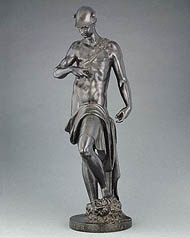1. Start this lesson on the plaza level of the Museum's North Pavilion at the Getty Center in the bronze sculpture gallery, and then move upstairs to the Renaissance paintings.
2. Give each student a copy of the The Perfect Body: Gods and Goddesses worksheet and a pencil. Activities on the sheet have students look for objects in the galleries and answer questions, sketch, and write about them.
3. Ask the students to find paintings and sculptures of Greek and Roman gods and goddesses. They can check which god or goddess they found by reading the label on the wall next to the work of art.
4. On their own, or as a group discussion, have students answer the questions on the worksheet. Have a discussion about the ways artists depicted gods and goddesses and how Renaissance ideas of a perfect body influenced these images.
5. Have students complete the last two activities on their own. The first one asks them to sketch or describe in words a god or goddess who has a body that comes the closest to their ideal of perfect. The second activity asks students to pretend they are a Renaissance artist and come up with a list of all the physical qualities of the perfect male and female body in the Renaissance. |
 |
 |
 |
| Mercury, Alessandro Vittoria
|
 |
|



